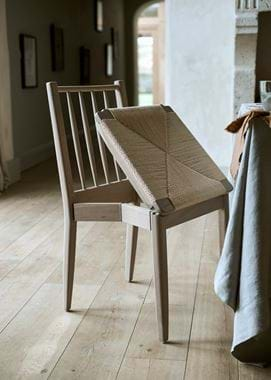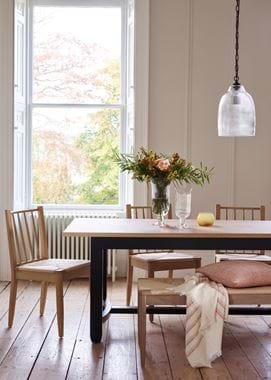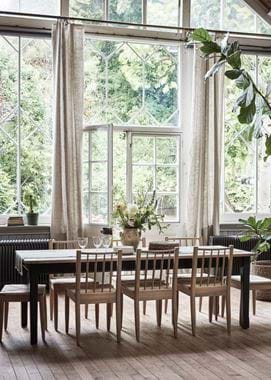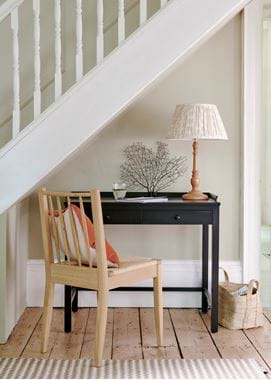Hidden heroes: the Wycombe folding chair
Hidden heroes: the Wycombe folding chair
Everything we do at Neptune is about making your life better in ways big and small. Sometimes that’s simply just a case of creating something that’ll bring beauty to your home, or allow you to express your personality. A lot of the time though (and especially when it comes to furniture which is not only an investment but must earn the space it takes up in your home), it’s about really considering the way you live and designing pieces which feel effortless to use. We call these our hidden heroes, because although you might not always immediately notice their craftsmanship and engineering, you’ll hopefully feel the positive effects.
Our Wycombe folding chair is just such a hero. It came about because, as much as we love extending dining tables and all the versatility they offer, you’re either left trying to find seats from around the house to pair with yours when it’s extended, or you have to store your extra chairs when you’re not using them. And we hadn’t quite found a folding chair that felt as well made, beautifully designed and solid as we would like. That was, until we spotted an antique one that sparked our modern reinterpretation.
Let’s back track a moment though. The folding Wycombe is just one part of a whole family of oak and woven cord seating. And before we even thought to make a collapsible chair, a number of influences had already gone into making the collection. Antique Shaker furniture, for one, with its unadorned simplicity. We also studied William Morris’s Sussex chairs from the 1860s, with their spindle backs and rush seats. ‘Thinking about comfort, we looked at their unique ergonomics – the seats are firm, but still forgiving to sit on,’ says Henry, Wycombe’s designer. ‘But to bring the chair up to date, we streamlined the shape so it has a minimalism to it that can work in either contemporary or traditional spaces. We also updated the materials, choosing natural oak over dark-stained ash and pale-coloured paper cord over raw rush.’
And then came our third inspiration: folding campaign furniture, especially the kind used on old passenger ships. The idea came about partly because our co-founder, John, loves sailing, so he’s keenly aware of why boat furniture needs to be compact and versatile. That started us thinking about campaign furniture generally, and how it was once used by travellers to save space and make their lives easier.
Although it’s been around since Roman times, campaign furniture was most popular during the time of the British Empire. As well as collapsible chairs that could be taken on long journeys by army and naval officers (or civilians moving to the colonies), there were also folding dining tables, chests of drawers that broke up into sections (known as ‘campaign chests’) and portable beds. Even small items could be packed away into box-like forms – think mirrors, lamps and cooking utensils. One type of candlestick whose components fitted inside a rounded container was charmingly known as a ‘Brighton bun’.
Most campaign furniture was made bespoke, so it could be adapted to the needs and tastes of its owner. Some craftsmen made a virtue of the hinges, bolts and buttons that signalled a design’s convertible nature; others took pride in concealing those same details, provoking surprise and delight when the true nature of an item was revealed. Such pieces found an audience far beyond the military, too. Single people in small homes, for instance, appreciated side tables that unfolded to form sets of library steps, or that had raised ‘fiddle rails’ around the edges. These were designed to stop objects sliding onto ships’ decks in high seas, but if the table top was lifted off, it magically became a tray.
The invention of express travel led to a decline in campaign furniture, as did a shift in class attitudes. One high-ranking army officer in India apparently needed a hundred elephants to transport his campaign kit across the River Ganges, while another lugged a baggage train that stretched for eighteen miles. Such extravagance was frowned upon by this point, and in any case, it seemed to fly in the face of campaign furniture’s original purpose: to make life simpler. Instead, it survived in other guises. Folding structures and fiddle rails are still essential on boats, where space is often tight and stability always an issue. Clever construction details also provide plenty of food for thought in the flat-pack era.
We like to think of Wycombe as poised neatly between the two, with the craftsmanship of one and the convenience of the other. ‘It needed to be both easy to store and to still look good when it’s in use. We really didn’t want it to feel any different to the fixed Wycombe chair,’ explains Henry. So, on each of the side rails on its oak frame, there’s a discreet hinge – simply lift the woven seat and these hinges fold, concertina-style, so the whole thing sits flat. As it still stands on all four legs, it won’t tumble over when you put it in a cupboard or stash it behind a door either. And that’s just one more way life’s made that bit easier.











